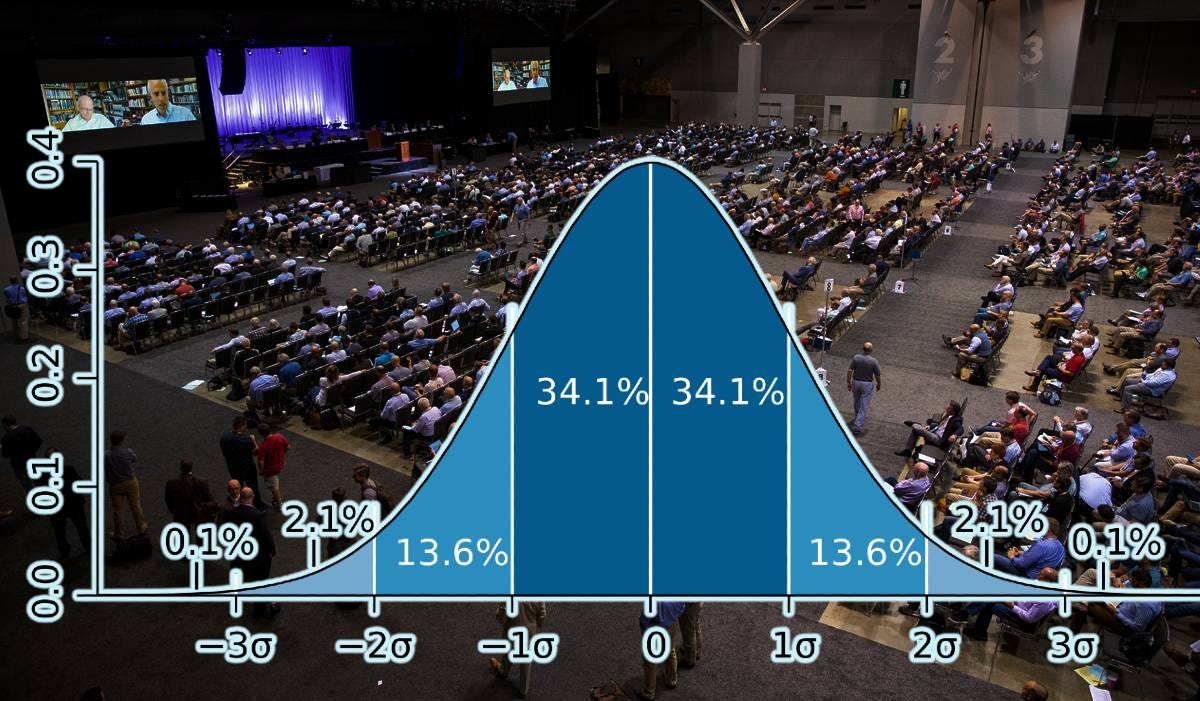By Brad Isbell
Just as certain ratios recur in the natural world, so does the normal distribution (or bell curve) prove helpful in thinking about things ecclesial. At the beginning of the Presbyterian Church in America’s sixth decade, a couple of roughly 15%-70%-15% distributions seem to stand out…and invite analysis.
Standard disclaimer: If analyzing divisions, trends, percentages, or distributions concerning the church strikes you as offensive or divisive, please stop reading now.
The first approximately 15% segment is churches with second/evening worship services. An informal study suggested by two PCA members found that a bit more than 12% of PCA churches have a second/evening worship service. This data was gleaned from PCA church websites and even the authors would not claim 100% accuracy. My guess is that the number is just a bit low—something nearer 15% is likely. The presence of evening worship services (not identical to morning services) may suggest something about a church and the convictions of her officers (since second services don’t occur by accident), but more about that later.
The second approximately 15% segment is churches that are (usually) egalitarian-leaning and employ ecclesial modifications and attenuations—the innovators. This category is sure to provoke pushback, but let me try to explain. Under this heading, I’d place PCA churches that:
Downplay presbyterian distinctives by, for example, not clearly identifying themselves as PCA on their church websites, listing “staff” but not officers on the web or in bulletins, employing scaled-down, minimalist, or alternative doctrinal statements for public consumption. They are quite intentionally not “presby maxing.”
Have heavy, regular involvement of unordained persons in liturgical roles in worship services. This goes beyond having women or young people in the rotation to read scripture. What I have in mind is much, if not most, of the worship service leadership (besides the sermon and benediction) being conducted by unordained persons. This is “representation maxing,” and it is intentional.
Get “creative” regarding office and officers. This phenomenon (covered here) was vividly illustrated in the recent PCA General Assembly in the passionate but unsuccessful fight to head off an amendment to restrict the use of officer titles to…officers. The range of manifestations of this (motivated by matters of polity conscience and city-positive contextualization?) include not ordaining any deacons (so as to have a unisex board), representing unordained persons as officers, using the non-standard term “deaconess” recklessly or confusingly, and (very rarely) referring to unordained persons as pastors. Add to these the practice of having “advisors” who seem to function as quasi-officers (staffing season committees and regularly participating in session meetings).
These things also may suggest something about a church and the convictions of her officers (since their presence is also no accident).
The most interesting thing about these two alleged 15% segments is that there seems to be virtually no overlap between them. Find a PCA church with evening worship (in addition to morning worship) with two full sermons on the Lord’s Day AND unordained “deacons” serving on a unisex board and—to be frank— you’ve found something like a sasquatch riding a unicorn.
So what do these two “outlier” segments say about the churches in them? The evening worship churches obviously prioritize preaching (since they have twice as much as single-service churches) and the so-called ordinary means of grace. They may be more Lord’s Day-focused and less “outward facing” (by some standards) than other churches. Members of these churches probably spend 3-6 hours at church per Sunday. The “innovators” may spend less time at church (and in worship) on the Lord’s Day but more time on things like small groups, community ministries, or fellowship.1 The “innovators” (with their outward-facing emphasis) may have ministries that are more “horizontal,” age-segmented, or community-focused than those of the evening worship churches. The evening worship churches worship, minister, and structure themselves in ways much more in keeping with Reformed churches of the last five centuries, but that doesn’t mean they are necessarily better or more faithful. The differences, though, are stark and undeniable. And they bear thinking about.
What does all of this say about the (approximately) 70% in the so-called middle? Maybe not much—the basically conservative, center-right, mix of Reformed and evangelical middle has always been around. They are perhaps more open to innovation and informality than the more traditional 15%. But in today’s chaotic cultural climate, the middle may prefer the more modest and traditional approach in the “negative world” of 2024. Recent General Assembly votes and actions tend to support the idea that the PCA middle is becoming more skeptical of innovation. Missional modesty seems to be the trend for the 70%.
Some may protest that Sunday evening worship cuts into family and fellowship time, but all the time at church—before, during, and after worship—is family and fellowship time. Evening worship churches are just as likely to share meals and hang around after (both) worship services as are others.





The common supper after our evening worship service has promoted more fellowship than I've seen and experienced in 31 previous years of membership in our previous PCA churches that didn't have evening services. Full disclosure: we are now 'independent presbyterians' with PCA ministers - prebymutants.
We must pray that many, many more churches in the PCA recognize the essential necessity of evening worship.